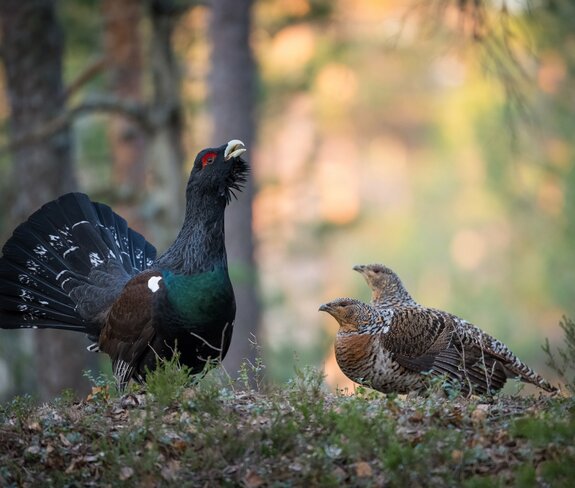
The capercaillie in the Brandnertal
A special inhabitant of the Alps
In Brandnertal, nestled between mountain peaks and dense forests, lives the capercaillie. This wood grouse, which is native to the high alpine regions of Europe, is not only a symbol of the untouched nature of the region, but also an important indicator of the health of the ecosystem. All the better that our region is home to the largest local capercaillie sub-population and an important source population. The region is therefore an important conservation area for this bird species, which is protected under the EU Birds Directive.
Insights into the life of the capercaillie
The capercaillie, also known as Tetrao urogallus, is one of the largest chicken birds in Europe. The males, often referred to as "gamecocks", are particularly impressive with their dark plumage, the bright red crest above their eyes and a striking fan of tail feathers. The females, also known as "hens", are smaller and are distinguished by their camouflage-colored plumage, which helps them to hide in the dense forests.
Habitat and behavior
The capercaillie finds ideal living conditions in the Brandnertal. The dense coniferous forests, interspersed with clearings and moors, offer the shy bird not only protection but also sufficient food. Capercaillie prefer quiet areas away from human activity. Especially in winter, they retreat to higher forests where they feed on pine needles and other plants.
The mating season in spring is a special spectacle for the capercaillie. With spread tail feathers and loud singing, they try to impress the females and demonstrate their territorial claims. Our magnificent sub-population in the Brandnertal suggests that the male capercaillies are masters of the courtship dance.
Threats and protective measures
Despite its adaptability, the capercaillie has become increasingly endangered in recent decades. In Brandnertal, great importance is therefore attached to the protection of this impressive bird species. Targeted measures such as the preservation and promotion of near-natural forests, the establishment of quiet zones and raising awareness among visitors are aimed at ensuring the long-term survival of the capercaillie.
- Designated wildlife quiet zones offer important retreats for the capercaillie. In these year-round wildlife rest areas, access is prohibited.
- The signposted roads, hiking trails and marked ski runs and cross-country ski trails may be used, but not left.
- Targeted guidance of ski tourers through designated ascent routes and descents via existing ski routes and pistes is intended to reduce disturbance and improve the quality of the quiet zone.
- As wild animals are particularly active at dawn and dusk, bike park trails may only be used during operating hours.
Interesting facts about our capercaillie
Size and weight:
- Capercaillies can reach a length of up to 100 cm and weigh between 3 and 6 kg. The females are significantly smaller, weighing around 1.5 to 2.5 kg.
Habitat:
- The capercaillie lives mainly in dense coniferous forests with clearings, moors and heathland. It prefers remote, undisturbed areas. The largest native chicken bird lives at 1.000 to 1.700 m above sea level.
Diet:
- Capercaillies feed on buds, berries, insects and pine needles. In winter, pine needles are an important source of food.
Courtship behavior:
- The mating season takes place in spring. The males perform impressive courtship dances to attract females and mark their territories.
Reproduction:
- After mating, the female lays 6 to 10 eggs in May or June, which are incubated for about 26 to 28 days.
Life expectancy:
- In the wild, a capercaillie can live up to 10 years.
You can also find more information here.